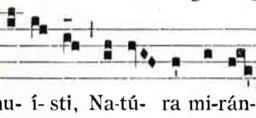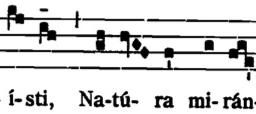Peculiar triangular noteheads
-
Can anyone tell me what the triangular noteheads mean? This is a solemn tone "Alma Redemptoris Mater" and these are the only two in the piece. I don't know the exact origin of this particular setting, but I was told it came from France.
Thanks and merry Christmas.

 IMG_2022.jpg2448 x 3264 - 2M
IMG_2022.jpg2448 x 3264 - 2M -
Curious indeed. And there is also a square note followed by a small round one. This must be some sort of rhythmic notation.
-
MJO, The rectangular notes are always the second of two tied notes, I've noticed. I'm pretty sure the little note is the equivalent liquescent neume.
doneill, I guess it could be. Actually I think you're right. I've never seen it written like this before. -
You are probably right about the liquescence.
My first thought was that this looked suspiciously like a deformed cephalicus.
What is the date of this odd example?Thanked by 1EMH -
Maybe it's a notation for repercussion?
-
I've posted this to another music forum I belong toThanked by 1EMH
-
It's where you fire the bazooka.
-
After comparing to square notation of the Solemn Tone, I'm pretty sure the triangle noteheads are equivalent to quilismas (probably not available in the software used to engrave the music). I also suspect that the small round note at the end of the first line is a liquescent. I wish I had more to go on, however.
Thanked by 1EMH -
Thanked by 1EMH
-
Thanked by 1EMH
-
MJO, I'm afriad I don't know the date. It was sent to a friend of a friend as an email attachment (supposedly from a monastery in France), and a printed copy found its way to me.
CHGiffen, here's a scan. I have the other Marian antiphons, too, some with the strange triangles.
Thanks for the comments.
 Alma Solemn Tone.pdf54KThanked by 1CHGiffen
Alma Solemn Tone.pdf54KThanked by 1CHGiffen -
I notice in the Canto Ambrosiano copy, a question mark before the notes for nu in genuisti, is this a recognized symbol for "oops this should be a tone above but I didn't leave enough space in the typesetting"? It is a tone higher (the only high E in the tune) in the EMH copy. I can't play the recording to check what they think, possibly because for copyright and DRM purposes my computer thinks its in the UK.
-
a f hawkins
This chant appears to be from the Canto Ambrosiano website, It is common on that site for such figures to appear. I think it is their way of saying that manuscripts differ over those neumes. -
In the recording, the (question marked) podatus on the syllable "-nu" in genuisti is sung on fa-sol (rather than the question marked mi-fa), in accord with the scan provided by EMH. FWIW, I think that is the "correct" interpretation.Thanked by 1a_f_hawkins
-
While the Solemn tone of this Marian Anthem should be well known... there are a number of differences between different usages, I have just taken the 'nu' as an example
Here is the Monastic Tone, from the Antiphonale Monasticum pg. 173,
Here is the Ambrosian tone, from the Liber Vesperalis Ambrosiano pg. 807,
Here is the Roman from the L.U. pg. 273,
N.B. For further comparisons the A.M. is available from CC Watershed, The L.V.A. can be found using google, and the L.U. is one of the books available from the CMAA.
 Mon.jpg361 x 118 - 16K
Mon.jpg361 x 118 - 16K
 Amb.jpg378 x 114 - 17K
Amb.jpg378 x 114 - 17K
 Rom.jpg189 x 99 - 9KThanked by 1CHGiffen
Rom.jpg189 x 99 - 9KThanked by 1CHGiffen
Welcome to the MusicaSacra Forum!
To participate in the discussions on Catholic church music, sign in or register as a forum member, The forum is a project of the Church Music Association of America.
Categories
- All Discussions21,074
- General Music Discussion8,206
- Job Openings193
- Management of Music Programs850
- Choral Matters532
- Church Documents and Rubrics524
- CMAA Notes300
- Events713
- For Newcomers: Read First26
- Sacred Polyphony546
- Hymnody871
- Gregorian Chant: General2,694
- ↳ Graduale Romanum and Liber Usualis367
- ↳ Graduale Simplex60
- ↳ Semiology63
- Vernacular Plainsong696
- Anglican Use and Anglican Chant68
- Organ, Other Instruments and Repertoire434
- New Composition/Works in Progress1,288
- Recordings230
- Music for Hispanic Ministry159
- Music Education: Children211
- Music Education: General222
- News Items245
- Positions Wanted2
- General Discussion: Catholicism738
- Amusements176
- General Discussion1,033
- Opinions117




